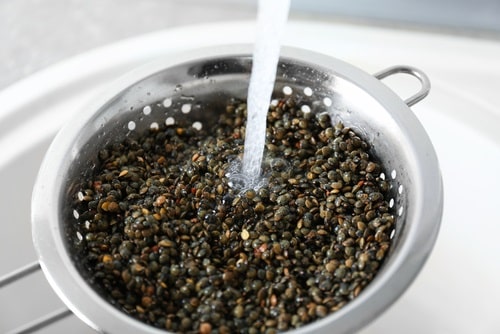
Lentils are cooked all over the world, using a variety of recipes. They are one of the cheapest staples you can find in a grocery store and tend to absorb the flavors of whatever they are cooked with.
This makes them great in soups, salads, curries, and even burger patties. They’re delicious but also great healthy food.
Lentils are packed full of protein and fiber, making them an especially appealing option to vegans, vegetarians, and those looking to add protein to their diet on a budget.
Before adding lentils, there are some important things that you should know. What exactly are they? What is their nutritional content? And importantly, are lentils safe to eat raw or undercooked?

This article will give you relevant information about the benefits of fully cooked lentils and the potential dangers of undercooked lentils.
What Exactly are Lentils and What is Their Nutritional Content?
Generally, people assume lentils to be a type of bean, and in a way, they are correct. Lentils, beans, and peas are all cousins in the legume family.
Lentils are considered a grain legume, known as a pulse. This means that the part we eat is actually the seed, filled with fiber and protein.
Because of this, they do have a husk which may or may not be removed when you purchase them in your supermarket. Lentils themselves come in a variety of colors, mostly brown, black, red, and green.
Cooked lentils are filled with protein, fiber, iron, zinc, and magnesium. This makes them a great substitute for meat in a vegan or vegetarian diet.
In addition to this, most of their carbohydrates are in the form of slowly digested starches, making them especially valuable to people with diabetes.
Lastly, they are gluten-free, meaning that those with gluten intolerance need not worry about them.
Are Undercooked Lentils Harmful to Our Bodies?
The simple answer is yes, undercooked or raw lentils are harmful to the human body.

When lentils are raw, they contain lectin protein that sticks to the digestive tract and results in various unpleasant reactions.
Raw legumes are estimated to cause around 20% of food poisoning cases worldwide, and eating raw lentils can leave you vomiting or diarrhea.
Luckily lectic proteins are heat sensitive, and they break down when the lentils are cooked, leaving you with a perfectly safe and delicious meal
As a result of this, lentils should always be fully cooked, never crunchy.
How Can We Avoid Mistakes When Cooking Lentils?
1. When people start cooking lentils, they tend to make a few mistakes. The first mistake is purchasing old lentils.
Technically speaking, lentils can last a few years on a shelf and will not make you sick even if they are past their expiry date, they will still be safe to eat.
The main problem is that the texture will not be the same. You can cook old lentils for hours, and they will never properly soften.
This means that you should always look for the freshest lentils possible, the same way you would with bread or meat.

2. The second mistake people make is not sifting lentils before cooking. Lentils sometimes have small pebbles hidden in the packets, which can make for a nasty experience.
Make sure to rinse and sift through every lentil packet to ensure that no stray bits of rock end up in your delicious soup!

3. The third mistake is not adding any or enough spices and flavorings to the pot. Lentils by themselves are bland in the same way that rice or bread is.
This makes them the perfect base to hold delicious flavors from bay leaves, rosemary, garlic, or onion powder. Be sure to add enough herbs and spices to your lentils to give them the taste that your dish deserves.
4. The fourth mistake is adding salt or any acidic ingredients such as vinegar to the pot too early.
You should only add salt or acidic ingredients once the lentils are done cooking and gently stirred into the dish.

5. The last mistake is cooking lentils on too high heat. If the heat is too high, the lentils will split their skins, let water inside, and leave you with a mushy and unappetizing dish.
First, bring the lentils to the boil and then reduce the heat, allowing them to simmer at a low temperature for a longer period of time.
This will ensure that they will have a soft, not mushy, texture when they finish cooking.
Conclusion
In conclusion, we can see that lentils must be cooked correctly to ensure they are a healthy and delicious addition to your meal.
Too much cooking and they can turn mushy, too little and they can be harmful. While this may sound daunting, you will soon get used to just how long they take to cook on your stove in your specific pots.
Once you do, you’ll find yourself adding them to just about everything! Be sure to leave a comment below telling us your thoughts, your favorite lentil dishes, or any questions you might have.